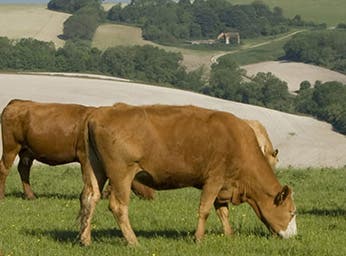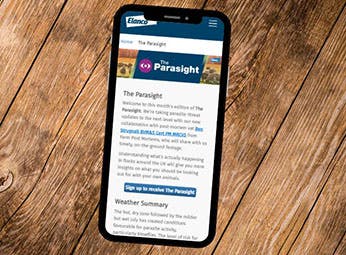Ectoparasites that affect cattle
Ectoparasites that affect cattle include nuisance flies, lice and mange mites. All of these can significantly affect herd welfare, health and productivity.
Nuisance flies
Flies can cause irritation, stress and seriously affect productivity. The main months for fly problems are May-August, but due to changing weather patterns the season can change.
The most common species that affect productivity are:
- Non-biting flies – house flies and face flies: these flies do not bite, but they breed easily in manure, quickly forming large numbers which can cause great irritation and transmit diseases. Animals that are distracted by flies will graze less and hence not perform as well.
- Biting flies – horse flies and stable flies: these flies deliver extremely painful bites, with both male and females feeding on blood. Horn flies are blood sucking flies and are extremely irritating, and can cause production losses.
Fly control: Flypor™ is a pour-on insecticide containing the synthetic pyrethroid permethrin 4% w/v. It provides up to 8 weeks’ long-lasting control of nuisance flies, particularly biting flies and horn-flies, so is useful to be applied at turnout.
Lice in cattle
Lice are mainly a problem with housed cows in the winter and can reduce dairy productivity. Symptoms include itching, hair loss, hide damage and, in the case of sucking lice, anaemia.
- Sucking lice pierce the skin and suck the blood and can cause anaemia. They tend to be found around the head and neck of cows.
- Biting lice feed on skin debris, blood and scabs. They tend to be found on the neck, shoulders, back and rump.
Control of lice: Flypor™ synthetic pyrethroid (SP) pour on insecticide controls both biting and sucking lice so is useful to be applied at housing.
Mange mites in cattle
Mange mites cause irritation, thickened scaly skin, hair loss, hide damage and reduced dairy productivity. These are mainly a problem in autumn, winter and early spring. Different mites cause different types of mange in different body areas as follows:
- Chorioptic mange is the most common type of mange in cattle in the UK, and is caused by the surface mite Chorioptes bovis. These mites live on or near to the surface of the skin and feed on skin secretions and debris. Signs of chorioptic mange are lesions usually seen on the feet, legs and base of the tail and udder.
- Sarcoptic mange is caused by the burrowing mites Sarcoptes scabiei (scabies mites). They cause intense irritation and result in large areas of skin becoming thick, crusted and often infected. These lesions are typically located on the neck, head and tail base.
- Psoroptic mange is caused by Psoroptes mites that cause severe dermatitis, scabs and intense itching, typically along the back, shoulders and tail. head.
Control of mange mites: Flypor™ synthetic pyrethroid pour on treats both sarcoptic and chorioptic mange.
Flypor™ 4% w/v pour-on solution contains permethrin (cis:trans 80:20). POM-VPS.
Further information is available from the Summary of Product Characteristics. Advice should be sought from the medicine prescriber prior to use. Prescription decisions are for the person issuing the prescription alone. Use medicines responsibly
Flypor™, Elanco™ and the diagonal bar logo are trademarks of Elanco or its affiliates.



